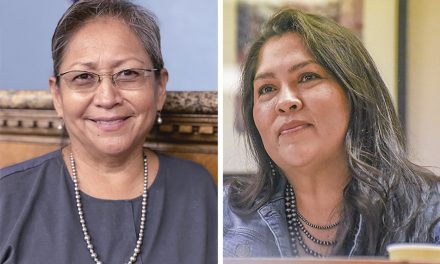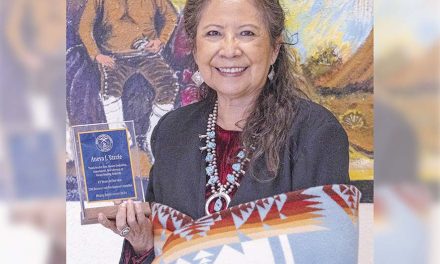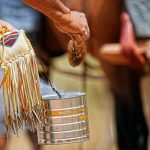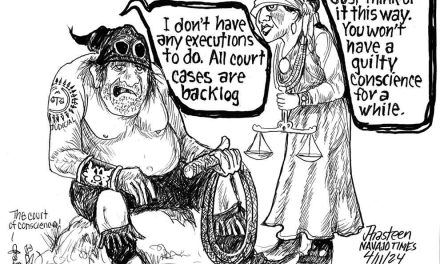
50 Years Ago: Exit Ted Mitchell, enter Sonny Jim
When it came to Ted Mitchell, the head of DNA-People’s Legal Services, Navajo leadership was showing no signs of backing off attempts to get him permanently banned from the reservation. Mitchell’s problems had begun just over a year prior when Annie Wauneka, one of the most powerful members of the Navajo Tribal Council, claimed he laughed at her while she was speaking at a committee meeting. She had confronted him and slapped him in the face.
The following day, the Council’s Advisory Committee, citing their authority to remove dangerous non-Indians from the reservation, banned him from the Navajo land. This forced Mitchell to set up an office first in a Gallup hotel and then in a trailer in Tse Bonito, just across the state border from Window Rock. A federal district court in Phoenix then ruled in his favor, saying the tribe had failed to give him due process under the recently passed Indian Civil Rights Act.
Mitchell was allowed back on the reservation but Navajo Tribal Chairman Raymond Nakai continued to be unhappy, saying the decision was a blow to tribal sovereignty. The tribe by this time had spent more than $50,000 to keep Mitchell from coming back on the reservation, but Nakai ordered the tribe’s general counsel, Harold Mott, to file an appeal.
Mott urged him to reconsider, saying he did not think an appeal would be winnable. Nakai told him to go ahead with it anyway. In the appeal, Mitchell was called an “obnoxious guest … ejected by his host.”
The tribe also argued that Mitchell was given due process and that the Indian Civil Rights Act was not meant to protect whites on the reservation. As expected, the tribe lost the appeal but did not have to put up with him very long because a few months later he quit his job and moved to Indonesia to head a legal aid program there.
In other news, the Gallup Inter-Tribal Indian Ceremonial was held this week 50 years ago and everyone reported that the rodeo stock was especially hard on the cowboys this year, with almost everyone being bucked off the horses and bulls. This was also the rodeo where Sonny Jim, a Modoc from Oregon, started becoming a rodeo legend.
Jim broke his arm in the first round of competition but this didn’t stop him from competing and becoming one of the top money winners. Jim was a winning cowboy for next two decades and became one of the best-known rodeo stars of his generation on the Navajo circuit. True West Magazine did a feature article about him in 2010, saying he “lived in the Wild West and died in the Wild West way.”
“Sonny Jim was an impressive guy,” the article stated. “He would have been the perfect model for a New West magazine – not only in his dress but also in his physical attributes.
“He was remarkably handsome and at 6 ft. 1 inches and about 200 some pounds, standing straight as an arrow and moving with the gracefulness of a mountain lion, he looked like an athlete,” the article reported. “But even more importantly, he greeted everyone with a winning smile and with kind words, he listened intensely, making people feel important,” the article said.
I met him for the first time shortly after I started covering Navajo news in 1970. I went to my first rodeo a couple of months after I got here, just a naive reporter from Kentucky with no knowledge of the sport. Dean Jackson, the first rodeo cowboy I ever got to know, pointed him out to me one day and told me I if I wanted to sell papers, I should do a story about Sonny Jim every week. “You don’t even have to be accurate,” he said, “because there are already so many stories about him that no matter how outlandish the story, everyone would believe it.”
While I didn’t write a story about him every week, I easily wrote more than 200 stories about him over the next four decades and probably could have done 200 more if I had time. And they weren’t all about rodeo. He was trained as a medicine man and helped me on a number of stories I wrote over the years on that subject. Both he and Jackson also went out of their way to push for stories about problems within the All-Indian Rodeo Cowboy Association and its counterparts.
I also remember doing a story here and there on his various business ideas and efforts to improve the quality of living for people on the reservation. It seemed that every time I saw him he would have a story or two for me. ?He had married into the Navajos so when I did a story about members of other tribes who lived and worked on the reservation, he was the first person I contacted.
“You would never find a more friendly group of people than the Navajos,” he said. “They’re generous with their time and will go out of their way to show you are welcomed.” He was like that himself, which may have attributed to the tragic events that led up to his death in 2009. It was one of the hardest stories I ever had to write.
Jim was a good friend of Wayne Johnson, a rancher in the San Rafael area. Johnson was in ill health and Jim would often stop by to help him shop or with his ranch chores. On this fateful day – Oct. 23, 2009 – Johnson told him that he had given a fellow by the name of Danny Stanfield permission in 2005 to live on his land. But, it seemed by 2009, he had outstayed his welcome and Johnson asked Jim to go with him when he told Stanfield it was time to move out.
Jim said “No problem,” so he and Johnson, along with another ranch hand, went to give the message to Stanfield. When they told Stanfield he needed to vacate, he began arguing with Johnson and then went into the bus he was living in. He came out a few seconds later with a gun. As soon as he saw the gun, Jim got on his cell phone and called the police. Stanfield pointed his gun at the three men and said he was making a citizen’s arrest. Jim apparently made a move toward him and was shot in the chest. Stanfield then took a couple of shots at the ranch hand and missed.
Johnson was taking a small Derringer out of his pocket when he was shot. Stanfield then reloaded his gun and shot Jim and Johnson in the head. Sheriff deputies arrived within minutes and arrested Stanfield who admitted shooting the two but said it was self-defense. Four years later, a district court judge in Grants sentenced him to two life terms but then assigned him to a mental institution. Jim’s family members protested, saying they felt Stanfield “beat the system.”
To get a real sense of Jim’s life, the True West article is on the web. Go to Google and type in “Sonny Jim.”







 Highway 264,
Highway 264, I-40, WB @ Winslow
I-40, WB @ Winslow